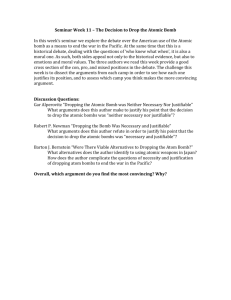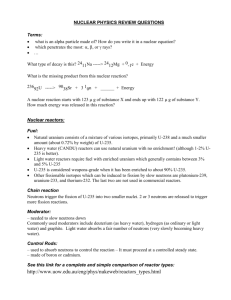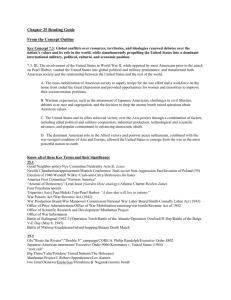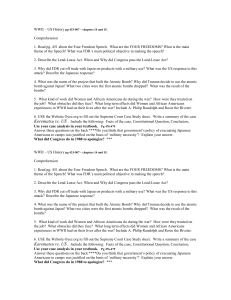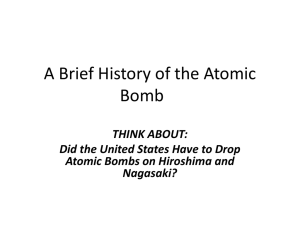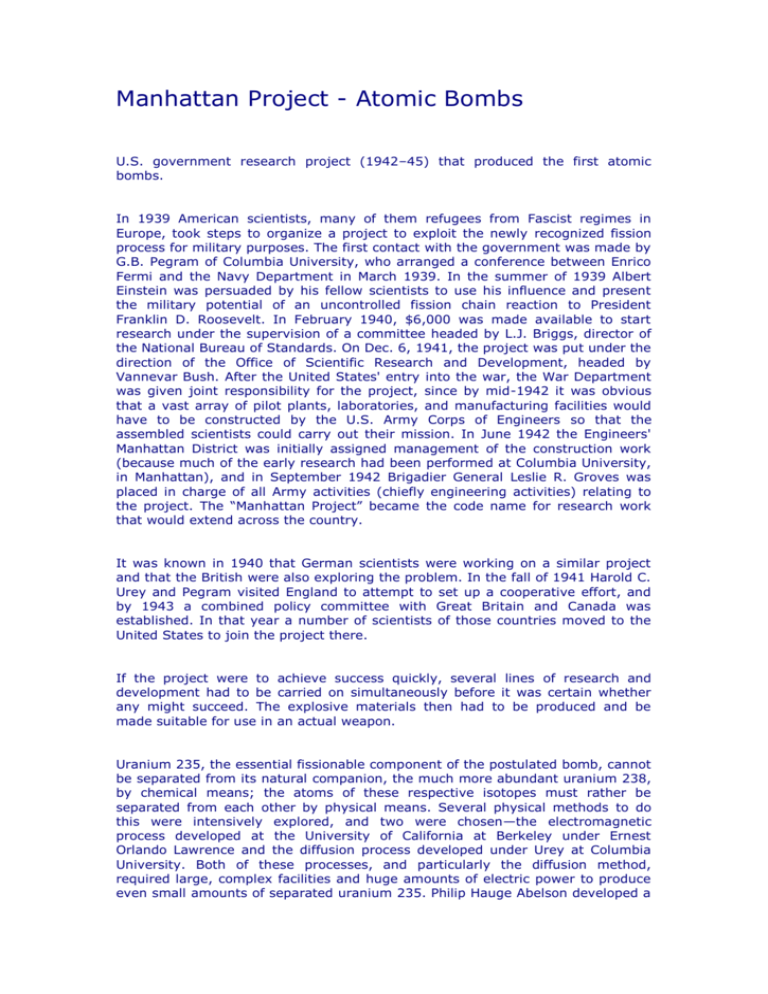
Manhattan Project - Atomic Bombs
U.S. government research project (1942–45) that produced the first atomic
bombs.
In 1939 American scientists, many of them refugees from Fascist regimes in
Europe, took steps to organize a project to exploit the newly recognized fission
process for military purposes. The first contact with the government was made by
G.B. Pegram of Columbia University, who arranged a conference between Enrico
Fermi and the Navy Department in March 1939. In the summer of 1939 Albert
Einstein was persuaded by his fellow scientists to use his influence and present
the military potential of an uncontrolled fission chain reaction to President
Franklin D. Roosevelt. In February 1940, $6,000 was made available to start
research under the supervision of a committee headed by L.J. Briggs, director of
the National Bureau of Standards. On Dec. 6, 1941, the project was put under the
direction of the Office of Scientific Research and Development, headed by
Vannevar Bush. After the United States' entry into the war, the War Department
was given joint responsibility for the project, since by mid-1942 it was obvious
that a vast array of pilot plants, laboratories, and manufacturing facilities would
have to be constructed by the U.S. Army Corps of Engineers so that the
assembled scientists could carry out their mission. In June 1942 the Engineers'
Manhattan District was initially assigned management of the construction work
(because much of the early research had been performed at Columbia University,
in Manhattan), and in September 1942 Brigadier General Leslie R. Groves was
placed in charge of all Army activities (chiefly engineering activities) relating to
the project. The “Manhattan Project” became the code name for research work
that would extend across the country.
It was known in 1940 that German scientists were working on a similar project
and that the British were also exploring the problem. In the fall of 1941 Harold C.
Urey and Pegram visited England to attempt to set up a cooperative effort, and
by 1943 a combined policy committee with Great Britain and Canada was
established. In that year a number of scientists of those countries moved to the
United States to join the project there.
If the project were to achieve success quickly, several lines of research and
development had to be carried on simultaneously before it was certain whether
any might succeed. The explosive materials then had to be produced and be
made suitable for use in an actual weapon.
Uranium 235, the essential fissionable component of the postulated bomb, cannot
be separated from its natural companion, the much more abundant uranium 238,
by chemical means; the atoms of these respective isotopes must rather be
separated from each other by physical means. Several physical methods to do
this were intensively explored, and two were chosen—the electromagnetic
process developed at the University of California at Berkeley under Ernest
Orlando Lawrence and the diffusion process developed under Urey at Columbia
University. Both of these processes, and particularly the diffusion method,
required large, complex facilities and huge amounts of electric power to produce
even small amounts of separated uranium 235. Philip Hauge Abelson developed a
third method called thermal diffusion, which was also used for a time to effect a
preliminary separation. These methods were put into production at a 70-squaremile tract near Knoxville, Tenn., originally known as the Clinton Engineer Works,
later as Oak Ridge.
Only one method was available for the production of the fissionable material
plutonium 239. It was developed at the metallurgical laboratory of the University
of Chicagounder the direction of Arthur Holly Compton and involved the
transmutation in a reactor pile of uranium 238. In December 1942 Fermi finally
succeeded in producing and controlling a fission chain reaction in this reactor pile
at Chicago.
Quantity production of plutonium 239 required the construction of a reactor of
great size and power that would release about 25,000 kilowatt-hours of heat for
each gram of plutonium produced. It involved the development of chemical
extraction procedures that would work under conditions never before
encountered. An intermediate step in putting this method into production was
taken with the construction of a medium-size reactor at Oak Ridge. The largescale production reactors were built on an isolated 1,000-square-mile tract on the
Columbia River north of Pasco, Wash.—the Hanford Engineer Works.
Before 1943 work on the design and functioning of the bomb itself was largely
theoretical, based on fundamental experiments carried out at a number of
different locations. In that year a laboratory directed by J. Robert Oppenheimer
was created on an isolated mesa at Los Alamos, N.M., 34 miles (55 km) north of
Santa Fe. This laboratory had to develop methods of reducing the fissionable
products of the production plants to pure metal and fabricating the metal to
required shapes. Methods of rapidly bringing together amounts of fissionable
material to achieve a supercritical mass (and thus a nuclear explosion) had to be
devised, along with the actual construction of a deliverable weapon that would be
dropped from a plane and fused to detonate at the proper moment in the air
above the target. Most of these problems had to be solved before any appreciable
amount of fissionable material could be produced so that the first adequate
amounts could be used at the fighting front with minimum delay.
By the summer of 1945, amounts of plutonium 239 sufficient to produce a
nuclear explosion had become available from the Hanford Works, and weapon
development and design were sufficiently far advanced so that an actual field test
of a nuclear explosive could be scheduled. Such a test was no simple affair.
Elaborate and complexequipment had to be assembled so that a complete
diagnosis of success or failure could be had. By this time the original $6,000
authorized for the Manhattan Project had grown to $2,000,000,000.
The first atomic bomb was exploded at 5:30 AM on July 16, 1945, at a site on the
Alamogordo air base 120 miles (193 km) south of Albuquerque, N.M. It was
detonated on top of a steel tower surrounded by scientific equipment, with
remote monitoring taking place in bunkers occupied by scientists and a few
dignitaries 10,000 yards (9 km) away. The explosion came as an intense light
flash, a sudden wave of heat, and later a tremendous roar as the shock wave
passed and echoed in the valley. A ball of fire rose rapidly, followed by a
mushroom cloud extending to 40,000 feet (12,200 m). The bomb generated an
explosive power equivalent to 15,000 to 20,000 tons of TNT; the tower was
completely vaporized and the surrounding desert surface fused to glass for a
radius of 800 yards (730 m). The following month, two other atomic bombs
produced by the project, the first using uranium 235 and the second using
plutonium, were dropped on Hiroshima and Nagasaki.
atomic bomb
also called atom bomb weapon with great explosive power that results from the
sudden release of energy upon the splitting, or fission, of the nuclei of such heavy
elements as plutonium or uranium.
When a neutron strikes the nucleus of an atom of the isotopes uranium 235 or
plutonium-239, it causes that nucleus to split into two fragments, each of which is
a nucleus with about half the protons and neutrons of the original nucleus. In the
process of splitting, a great amount of thermal energy, as well as gamma rays
and two or more neutrons, is released. Under certain conditions, the escaping
neutrons strike and thus fission more of the surrounding uranium nuclei, which
then emit more neutrons that split still more nuclei. This series of rapidly
multiplying fissions culminates in a chain reaction in which nearly all the
fissionable material is consumed, in the process generating the explosion of what
is known as an atomic bomb.
Many isotopes of uranium can undergo fission, but uranium-235, which is found
naturally at a ratio of about one part per every 139 parts of the isotope uranium238, undergoes fission more readily and emits more neutrons per fission than
other such isotopes. Plutonium-239 has these same qualities. These are the
primary fissionable materials used in atomic bombs. A small amount of uranium235, say 0.45 kg (1 pound), cannot undergo a chain reaction and is thus termed
a subcritical mass; this is because, on average, the neutrons released by a fission
are likely to leave the assembly without striking another nucleus and causing it to
fission. If more uranium-235 is added to the assemblage, the chances that one of
the released neutrons will cause another fission are increased, since the escaping
neutrons must traverse more uranium nuclei and the chances are greater that
one of them will bump into another nucleus and split it. At the point at which one
of the neutrons produced by a fission will on average create another fission,
critical mass has been achieved, and a chain reaction and thus an atomic
explosion will result.
In practice, an assembly of fissionable material must be brought from a
subcritical to a critical state extremely suddenly. One way this can be done is to
bring two subcritical masses together, at which point their combined mass
becomes a critical one. This can be practically achieved by using high explosives
to shoot two subcritical slugs of fissionable material together in a hollow tube. A
second method used is that of implosion, in which a core of fissionable material is
suddenly compressed into a smaller size and thus a greater density; because it is
denser, the nuclei are more tightly packed and the chances of an emitted
neutron's striking a nucleus are increased. The core of an implosion-type atomic
bomb consists of a sphere or a series of concentric shells of fissionable material
surrounded by a jacket of high explosives, which, being simultaneously
detonated, implode the fissionable material under enormous pressures into a
denser mass that immediately achieves criticality. An important aid in achieving
criticality is the use of a tamper; this is a jacket of beryllium oxide or some other
substance surrounding the fissionable material and reflecting some of the
escaping neutrons back into the fissionable material, where they can thus cause
more fissions. In addition, “boosted fission” devices incorporate such fusionable
materials as deuterium or tritium into the fission core. The fusionable material
boosts the fission explosion by supplying a superabundance of neutrons.
Fission releases an enormous amount of energy relative to the material involved.
When completely fissioned, 1 kg (2.2 pounds) of uranium-235 releases the
energy equivalently produced by 17,000 tons, or 17 kilotons, of TNT. The
detonation of an atomic bomb releases enormous amounts of thermal energy, or
heat, achieving temperatures of several million degrees in the exploding bomb
itself. This thermal energy creates a large fireball, the heat of which can ignite
ground fires that can incinerate an entire small city. Convection currents created
by the explosion suck dust and other ground materials up into the fireball,
creating the characteristic mushroom-shaped cloud of an atomic explosion. The
detonation also immediately produces a strong shock wave that propagates
outward from the blast to distances of several miles, gradually losing its force
along the way. Such a blast wave can destroy buildings for several miles from the
location of the burst. Large quantities of neutrons and gamma rays are also
emitted; this lethal radiation decreases rapidly over 1.5 to 3 km (1 to 2 miles)
from the burst. Materials vaporized in the fireball condense to fine particles, and
this radioactive debris, referred to as fallout, is carried by the winds in the
troposphere or stratosphere. Since the radioactive contaminants include such
long-lived radioisotopes as strontium-90 and plutonium-239, they can have lethal
effects for weeks after the explosion.
The first atomic bombs were built in the United States during World War II under
a program called the Manhattan Project. One bomb, using plutonium, was
successfully tested on July 16, 1945, at a site 193 km (120 miles) south of
Albuquerque, New Mexico (see photograph). The first atomic bomb to be used in
warfare used uranium. It was dropped by the United States on Hiroshima, Japan,
on August 6, 1945. (See Sidebar: The decision to use the atomic bomb.) The
explosion, which had the force of more than 15,000 tons of TNT, instantly and
completelydevastated 10 square km (4 square miles) of the heart of this city of
343,000 inhabitants. Of this number, 66,000 were killed immediately and 69,000
were injured; more than 67 percent of the city's structures were destroyed or
damaged. The next atomic bomb to be exploded was of the plutonium type; it
was dropped on Nagasaki on August 9, 1945, producing a blast equal to 21,000
tons of TNT. The terrain and smaller size of Nagasaki reduced destruction of life
and property, but 39,000 persons were killed and 25,000 injured; about 40
percent of the city's structures were destroyed or seriously damaged. The
Japanese initiated surrender negotiations the next day.
After the war, the United States conducted dozens of test explosions of atomic
bombs in the Pacific at Enewetak (Eniwetok) atoll and in Nevada. In subsequent
years, the Soviet Union (1949), Great Britain (1952), France (1960), China
(1964), India (1974), and Pakistan (1998) tested fission weapons of their own.
The great temperatures and pressures created by a fission explosion are also
used to initiate fusion and thus detonate a thermonuclear bomb. See also nuclear
weapon.
Atomic Bomb
Atomic Bomb, powerful explosive nuclear weapon fueled by the splitting, or
fission, of the nuclei of specific isotopes of uranium or plutonium in a chain
reaction. The strength of the explosion created by an atomic bomb is on the order
of the strength of the explosion that would be created by thousands of tons of
TNT (see Trinitrotoluene).
An atomic bomb must provide enough mass of plutonium or uranium to reach
critical mass, the mass at which the nuclear reactions going on inside the material
can make up for the neutrons leaving the material through its outside surface.
Usually the plutonium or uranium in a bomb is separated into parts so that critical
mass is not reached until the bomb is set to explode. At that point, a set of
chemical explosives or some other mechanism drives all the different pieces of
uranium or plutonium together to produce a critical mass. After this occurs, there
are enough neutrons bouncing around in the material to create a chain reaction of
fissions. In the fission reactions, collisions between neutrons and uranium or
plutonium atoms cause the atoms to split into pairs of nuclear fragments,
releasing energy and more neutrons. Once the reactions begin, the neutrons
released by each reaction hit other atoms and create more fission reactions until
all the fissile material is exhausted or scattered.
This process of fission releases enormous energy in the form of extreme heat and
a massive shock wave; this is the intense explosion. In addition to its nearly
unimaginable destructive force, consisting of pressure waves, flash burns, and
high winds, a nuclear explosion also produces deadly radiation in the form of
gamma rays and neutrons. The radiation destroys living matter and contaminates
soil and water.
Atomic bombs were the first nuclear weapons to be developed, tested, and used.
In the late 1930s physicists in Europe and the United States realized that the
fission of uranium could be used to create an extremely powerful explosive
weapon. In August 1939, German American physicist Albert Einstein sent a letter
to U.S. president Franklin D. Roosevelt that described this discovery and warned
of its potential development by other nations. The U.S. government established
the top secret Manhattan Project in 1942 to develop an atomic device. The leader
of the Manhattan Project was U.S. Army Brigadier General Leslie R. Groves. His
team, working in several locations but in large part at Los Alamos, New Mexico,
under the direction of American physicist J. Robert Oppenheimer, designed and
built the first atomic bombs.
The first atomic explosion was conducted, as a test, at Alamogordo, New Mexico,
on July 16, 1945. The energy released from this explosion was equivalent to that
released by the detonation of 20,000 tons of TNT. Near the end of World War II,
on August 6, 1945, the United States dropped the first atomic bomb on the
Japanese city of Hiroshima. It followed with a second bomb against the city of
Nagasaki on August 9. According to U.S. estimates, 60,000 to 70,000 people
were killed by the Hiroshima bomb, called “Little Boy,” and about 40,000 by the
bomb dropped on Nagasaki, called “Fat Man.” Japan agreed to Allied terms of
surrender on August 14th. These are the only times that a nuclear weapon has
been used in a conflict between nations.
Fusion bombs, also called hydrogen or thermonuclear bombs, were developed
and tested in the early 1950s, but these have never been used in warfare. A
thermonuclear device depends on a fission reaction to produce extreme heat that
causes hydrogen isotopes of deuterium and tritium to come together, or fuse, but
the main energy source for thermonuclear devices comes from the fusion
reaction, not the triggering fission reaction. For more information on this type of
bomb, see Hydrogen Bomb.
Several nations have exploded nuclear devices in tests in the atmosphere, under
the earth, and under the sea. Only the United States, Russia, the United
Kingdom, France, China, India, and Pakistan admit to possessing nuclear
weapons. South Africa admitted to having built and then dismantling a number of
bombs. Other nations, however, including Israel, are thought to have them as
well or to have the capability to assemble them quickly. See also Arms Control,
International.
Microsoft ® Encarta ® Reference Library 2003. © 1993-2002 Microsoft
Corporation. All rights reserved.



